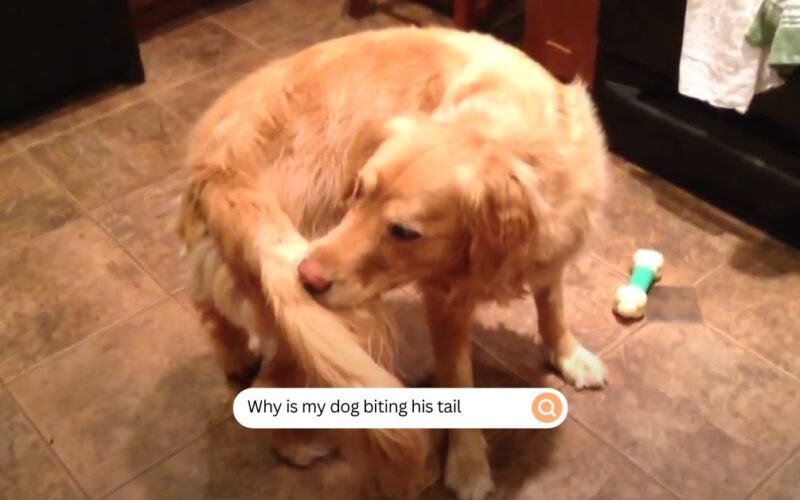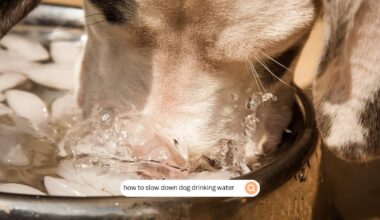About the Author: Jean Colt, a valued writer at MyPetDoggie and a dedicated student of English Literature at Yale University. Jean’s love for dogs, coupled with her literary skills, allows her to create engaging content that resonates with our pet-loving community. Her work reflects her passion for dogs and commitment to enhancing pet care knowledge.
You see your dog biting his tail and I am sure that it is stressing you out too because it seems unhygienic and annoying. But I have seen some dog owners happily smiling at their dogs while they bite their tails. I have to tell you that if you are worried then you are right it is a thing to worry about.
Biting the tail is not something to giggle about. It can be serious and dogs love it when you smile or cherish their behavior. They tend to repeat it more often and I guess you surely do not want that. Do you? So today we are going to delve deep into this topic to actually see what are the underlying reasons your dog is biting his tail and how you can help him overcome this habit.
Why Is My Dog Biting His Tail?
Your dog is biting his tail because of itchiness or irritation, anxiety and stress can be an issue also. Other than that issues of anal glands, internal injury, or parasites on the tail and spine would be the reason too.
Recent studies show that dogs also bite their tails when they sense sudden environmental changes such as thunderstorms or hailstorms.
Still, It is hard to detect the exact cause without examination but we can provide you with some more info regarding this issue. Some common reasons why you can be biting his tail can be:
Fleas and Other Parasites
Different parasites like fleas, mites ticks, etc. can be a reason for intense itching and can cause discomfort. When these parasites attack the tail of a dog or any other area of the body the dog can chew or bite their tail or affected area to get relief from itching. To prevent this issue I suggest regular flea prevention and parasite control.
Allergies
Due to different environmental factors, your dog can develop allergies to dust, pollen, or certain foods. Other than that it can be from products like cleaning supplies or fabrics. These allergies can cause irritation and itching, which can lead to biting on the tail or any other area that is itching.
Anxiety or Stress
Maybe your dog is suffering from some kind of stress or anxiety which can be because of different reasons. If your dog is biting his tail it can be considered a self-soothing technique. You have to address the underlying causes of the stress and anxiety after that you have to provide appropriate training and medication. It can help reduce this behavior.
Behavioral Issues
There are a few dogs that can have some kind of behavior issues that can include tail chasing or tail biting. Also, it can be a result of boredom, anxiety, or maybe frustration. You are required to have a dog behaviorist or training which can help you to identify the underlying issue by behavior modification technique.
Pain or Discomfort
There can be pain or some kind of discomfort in the tail or body which can lead to tail biting. Internal injuries, infection, or any underlying medical disease can cause pain which can lead to tail biting or chewing on the affected area. It is important to get a thorough diagnosis done.
Medical Causes for Tail Biting
Dogs can bite their tails due to different reasons and to make sure what is the reason it is important to connect with a vet. Some potential issues due to which your dog is biting his tail can be:
Skin Infections:
Bacterial and fungal skin issues can lead to itching and discomfort. This can lead the dog to chew his tail so he can get relief from the itching.
Anal Gland Issues
Another issue due to which your dog may bite his tail can be impacted or infected anal glands. This can be very uncomfortable and lead the dog towards tail biting to get rid of discomfort.
Wounds or Injuries
It is possible that your dog has some kind of internal injury or wound that can cause pain or irritation, prompting a dog to chew or bite the area where he has an injury or a wound.
Orthopedic Problems
The issue of tail biting can also occur if your dog has some kind of orthopedic issue which can be a tail fracture or a herniated disc. It can be painful or uncomfortable for the dog.
Neurological Disorders
There are different neurological disorders that can affect the ability of a dog to control his tail. This leads to excessive biting or tail licking. This is a reaction to abnormal sensations.
Joint Issues
Many dogs have some kind of joint issues like arthritis or hip dysplasia. They can experience discomfort in their tail joints which leads to biting and chewing the tail.
Dermatitis
It is a disease in which a dog has inflammation in the skin which can cause itching and discomfort which leads the dog to chew or bite the tail.
Underlying Pain
A reason for tail biting can be chronic pain from any source of the body which can lead to tail biting as a coping mechanism even if the pain is not in the tail still dogs can bite their tails.
Psychogenic Alopecia
Psychogenic Alopecia is a behavioral condition in which the dog licks or bites the tail due to stress, anxiety, or compulsive behavior. Traditionally we do not consider it a medical condition but it can lead to tail damage.
Autoimmune Disorders
There are some autoimmune disorders that can cause skin issues, and also itching which leads to biting of the tail in the affected area.
Cauda Equina Syndrome
It is a very serious spinal cord condition where the nerves at the base of the spine are compressed. This can cause pain and neurological symptoms which can cause biting of the tail.
It is important thing to note that tail biting can be due to different factors so a perfect diagnosis and treatment is very important. The treatment can include medicines, topical treatments, physical therapy, surgery, or other strategies depending on underlying issues.
The Importance of Treating Medical Issues
It is very important to treat medical issues so that the issue can be resolved at the initial stage and not lead to extreme pain or discomfort. It is important to treat these issues as Adrienne Farricelli, a dog trainer says that although tail chasing and biting may look like cute, playful fun, this type of behavior may actually be a symptom of an underlying problem.
Relief from pain and discomfort:
If a dog is experiencing some kind of pain or discomfort he can be seen biting his tail due to some underlying medical problem. Treating the root cause can help to get the dog relieved from the issue. If the problem is treated on time then you can improve their quality of life.
Prevent Further Injury:
Tail biting can lead to self-inflicted wounds and injuries. If you consult with a vet and find out the underlying medical issue then you can prevent these injuries from worsening or becoming infected.
Avoid complications:
There are many complications that are left untreated; it can lead to different serious conditions. For example, untreated skin infections can spread and orthopedic issues can also worsen with time. Treating the problem early can also prevent such complications.
Improved behavior:
Tail biting is stressful for the dog but it is also stressful for the owner. It leads to different behavior issues like increased anxiety or aggression. Treating these medical issues can also help restore the normal behavior of dogs and also improve their temperament.
Enhanced quality of life:
Often dogs are in pain and discomfort if they have a reduced quality of life. If you address this medical problem then their overall health can be improved.
Prevent Psychological Issues:
If your dog is biting his tail almost all the time then this can lead to different psychological issues like psychogenic alopecia or obsessive compulsive behaviors. If you treat the underlying issue then this can prevent the development of such issues.
Avoid long-term damage:
There are some medical conditions if they are left untreated then irreversible damage can occur. Neurological disorders or orthopedic problems can then lead to permanent disability which no one wants for their dogs. Early prediction and treatment can mitigate the extent of damage.
Reduce Stress:
If a dog is bothered by pain, itching, or discomfort very often then they will stay stressed. If you treat the medical issue then your dog is going to stay more comfortable and relaxed during and after treatment.
Cost Savings:
If a medical issue is predicted very early then it is going to be less expensive than dealing with the consequences of long-term untreated problems. If predicted early it can save you from complications and also you have to avoid extensive treatments which can save both emotional and financial resources.
Behavioral Causes of Tail Biting in Dogs
Tail biting can be attributed to various behavioral causes. It is important to consider these factors when you are addressing the issue.
Anxiety and Stress
Dogs often bite their tails when they are under stress. The stress can be because of environmental changes, unfamiliar situations, and even loud noises.
Boredom
Mentally and physically dogs are not stimulated; they can develop behaviors like tail biting out of sheer boredom. You have to provide them with appropriate outlets and mental stimulation can also help.
Compulsive Behavior
Some dogs can also develop compulsive behaviors like tail biting; it can be a response to their stress and anxiety. The behavior can become a habit that is very hard to break.
Attention-Seeking
Dogs are social animals and some of them may resort to tail biting in order to get attention from their owners. Once in attention, they learn this behavior they are going to continue it.
Separation Anxiety
If your dog has separation anxiety then there is a chance that they are going to engage in destructive behavior like tail biting when they are left alone. If you address their anxiety properly and provide them with training they can reduce this habit.
Lack of Socialization
It is important to socialize your dogs so they can cope with lots of problems and build confidence. The dogs who are not socialized properly can develop nervous or anxious behaviors which can lead to tail biting.
Frustration
When dogs become frustrated due to unmet desires or difficulties in obtaining something they want then they can redirect this frustration by biting their tail.
Redirected Aggression
If a dog is aroused by external stimulus then they can redirect aggression towards their own body which can lead to tail biting.
Hyperactivity
If a dog is very active then they may engage in tail biting as a way to release pent-up energy. To reduce this behavior regular exercise can help.
Attention-Deficit/Hyperactivity Disorder (ADHD)
It is not a formally recognized behavior in dogs but some dogs exhibit hyperactive behaviors like tail biting. These dogs can benefit from behavioral training and management.
Traumatic Experience
A traumatic event like an attack on another animal or a painful event that has a tail involved in it can lead to tail biting as a response. It can be associated with fear and pain.
Habitual Behavior
It has become a habit of some dogs even for medical reasons. In the start, you need a lot of effort to break this habit with a lot of time.
How to Remove Ticks from Your Dog Tails
It is very important to remove ticks from dogs and they can not be ignored. It is important to remove them from the tail of your dog as soon as you discover them. To remove ticks from your dog you need to follow the following steps and need the material given below.
Material you will need:
- Tick removal tools or fine-tipped tweezers.
- A good pair of disposable gloves.
- A small container with a cover to identify the tick.
- Antiseptic Solution or alcohol.
- Cotton balls or swabs.
- Treat or positive reinforcement so your dog can be rewarded afterward.
Steps:
- Prepare: start by putting on your disposable gloves. It will help you to stay safe from the potential tick-borne disease. Keep all your materials ready.
- Calm your dog: if your dog is looking anxious or wriggling make sure to calm them by speaking in a soothing voice and also offer them rewards and treats. If your dog is moving too much and you want him to hold steady then get someone’s help.
- Locate the tick: thoroughly examine the tail of your dog so that you can find the tick. It can be small so make sure to research properly.
- Use tweezers or a tick removal tool: grasp the tick as close to the skin as possible with the tool or fine-tipped tweezers. You have to be gentle but also firm.
- Pull slowly and steadily: very slowly and steadily pull the tick upward and away from the skin of your dog. You do not have to twist, jerk, or crush the tick as it can break and leave parts behind.
- Check for complete removal: make sure that you have removed the tick which includes the mouth and head parts. If any small part is remaining gently remove it by tweezers.
- Dispose of the tick: Place the tick in a small container with a small lid. You may want to save it for identification in the future in case the dog shows illness. Make sure to seal the container properly.
- Clean the area: it is important to use an antiseptic solution or rubbing alcohol to clean the bite area on the tail of your dog and your hands. After the procedure is done, dispose of the gloves you were wearing.
- Reward your dog: give your dog a treat and then lots of praise for staying patient throughout the procedure.
- Monitor your dog: keep an eye on your dog if he shows any signs of illness in the days following the tick removal. The signs can be lethargy, loss of appetite, or maybe fever. If any unusual symptoms are seen make sure to consult with the vet.
It is very important that you avoid methods like burning the tick with a match or suffocating it with petroleum jelly. These methods can irritate the tick and then lead to the release of harmful substances into the bloodstream of your dog. The safest way is to remove ticks promptly and quickly.
My Dog Keeps Chasing and Biting His Tail. What Should I Do?
If you are tired of your dog biting his tail then you need to quickly address the underlying issues. You can take the following steps:
Consult a Veterinarian
The first step you need to take is to rule out any medical conditions that can cause tail chasing and tail biting. There can be conditions like skin infections, allergies, pain, or neurological problems. A thorough examination by your vet is recommended also tests can be done too if important.
Environmental Enrichment:
Make sure that the environment of your dog is mentally stimulating you can provide toys, puzzles, and activities that can engage the mind of your dog and help prevent boredom which can contribute to tail chasing.
Regular Exercise:
Regular exercise is also very important to stay healthy. When your dog is tired then he will not engage in compulsive behavior like tail chasing. You can consider different activities like walking, playing fetch, or pool activities.
Positive Reinforcement Training:
You can use positive reinforcement techniques to stop irritating behaviors. These techniques can redirect the attention of your dog with treats and praise when they engage in tail biting.
Behavioral Modification:
If you want to stop your dog from tail biting then it is important to work with a professional dog trainer or a behaviorist. Who can develop a tailored behavior modification?
Calm Environment:
To reduce this behavior along with stress and anxiety then create a calm and structured environment. Make sure to cut out excessive noise, chaos, or stressors that can contribute to any kind of anxiety or stress.
Desensitization:
If you see that your dog is triggered by specific situations or objects then consider gradual desensitization to reduce the anxiety or stress associated with that object. It is important to get it done under professional guidance.
Medical Treatment:
If the vet identifies an underlying medical condition that leads to tail biting then follow with the recommended treatment. It can include medications or any other interventions that can address medical conditions.
Regular Grooming:
Make sure that the tail area is clean and free from any kind of skin irritations or matting that can cause discomfort. Regular grooming can help prevent skin issues which can lead to tail chasing.
Avoid Punishment
You should avoid scolding and punishment of your dog for tail chasing. It can increase stress and anxiety. Instead, you should focus on positive reinforcement and redirection techniques.
One thing that you need to remember is that stopping tail-chasing behavior can take time and patience. It is very important to stay consistent in efforts. If you are tired and unsure of how you are going to proceed and your efforts are not working then it is important to seek guidance from a professional.
Common Question:
Can I put coconut oil on my dog?
Yes, it is possible to use coconut oil on your dog. It can be applied topically on the skin and coat it is used to moisturize dry skin and relieve itching. This can promote a healthy coat. Other than that you can give it orally in small amounts as a dietary supplement but if you consult your vet he can help you with appropriate dosage. So that it is suitable for your dog’s needs.
Will dogs lick coconut oil?
Different dogs like coconut oil and then they lick it if it is applied on the skin or it can be offered as a treat. Not all dogs like the taste but you have to introduce it slowly. Also, you have to be cautious about allowing dogs to ingest large quantities. It can also lead to digestive issues as it has high fat content.
Why is my dog’s back itchy near his tail?
If the back of your dog near his tail is itchy it can be an alarming situation. It can be because of allergies, fleas, mites, skin infections, or anal gland issues. For proper treatment, you should consult with a veterinarian.
How do you check a dog for fleas?
Start combing gently your dog’s fur. You have to start from the head and work your way back.
Always pay close attention to areas where fleas tend to hide like the base of the tail and behind the ears or neck.
When you are combing keep looking for tiny brown or black specks on a comb or on the fur they can be flea feces which contain digested blood.
Why is my dog’s butt itchy?
Itchy butt can occur due to different reasons like anal gland issues, allergies or skin infections, or maybe even parasites. It is important to get your dog examined by a vet and get to know the underlying issue so appropriate treatment can be received.
Why does my dog keep biting her bottom?
Dogs can keep biting their bottom due to different reasons like itching due to skin allergies, skin irritation, fleas, anal gland problem, or maybe behavioral issues. You have to identify the underlying cause and then get it treated efficiently.
So,
If you are concerned that my dog is biting his tail then it can be due to different reasons explained above. All you have to do is identify the issue start proper treatment and address the behavior. I hope that you have gained enough information about tail biting from this article but I recommend consulting with a vet if your dog is getting really obsessed with this behavior. That’s all for today guys.






